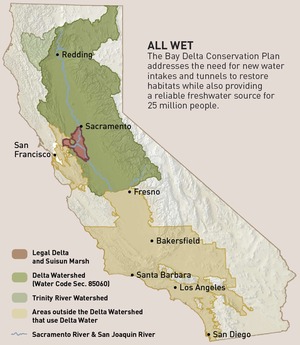
The cost of California Gov. Jerry Brown's Bay Delta Conservation Plan, or BDCP, will top $24.5 billion, according to a report released by the state on May 29.
When first proposed, the plan was estimated to cost $4 billion, then raised to $14 billion.
The state's BDCP report addresses the controversial project's issues of cost, funding and the need for new water intakes and tunnels to restore habitats in the fragile Sacramento-San Joaquin Delta area, the largest estuary in the U.S.
The plan would transport freshwater from the Sacramento and San Joaquin rivers to state water facilities without using the bay delta as the primary conduit. Construction would include two 40-ft-dia tunnels running five miles beneath the delta and 30 miles above ground, diverting 9,000 cu ft per second of freshwater into new water facilities. Levees also would be seismically upgraded and 145,000 acres of delta habitat restored.
The total cost estimate includes $14.5 billion for conveyance systems and the rest for capital costs, habitat restoration and operations and maintenance costs, says Mark Cowin, director of California's Dept. of Water Resources.
However, the estimates are still preliminary, and there are many different ways of looking at costs, Cowin cautions, adding that the overall estimate is for "undiscounted" 2012 dollars that don't consider discount rates or interest.
The plan calls for the project to be paid for over 50 years, with about 70% coming from agencies receiving water from the project and the rest coming from state and federal sources and bond measures. Dr. David Sunding, economics professor at UC Berkeley, says the cost to consumers along the water route would be about $5 per month for about 40 years.
In analyzing the economic benefits—increased water supply, quality and reduced seismic risk—versus the costs for state and federal water contractors, the report finds the benefits outweigh the project costs by 30% to 40%, yielding "a reasonable rate of return on water investment," Sunding says.
"This conservation plan provides the most comprehensive, well-conceived approach to ensuring a reliable water supply to 25 million people and restoring the delta ecosystem" says John Laird, secretary of the California Natural Resources Agency. A public review draft of the environmental impact report and statement is expected in October.


Post a comment to this article
Report Abusive Comment